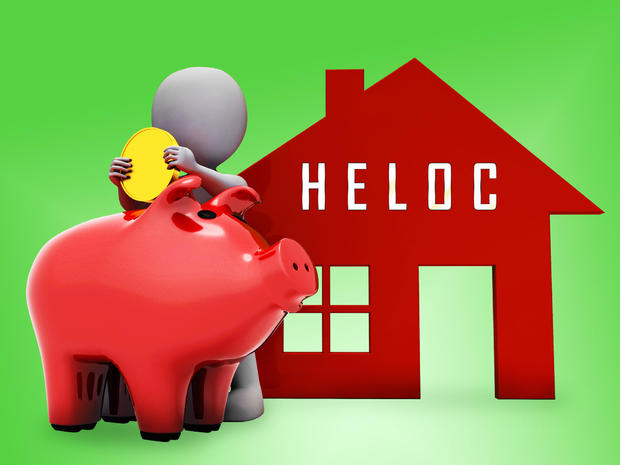3 smart HELOC refinancing strategies, according to experts
After the pandemic hit and the Fed dropped the fed funds rate to zero, homebuyers flooded the housing market. Partially as a result, the median sale price of U.S. homes spiked from $329,000 at the start of 2020 to $479,500 by the end of 2022, according to data analyzed by the Federal Reserve Bank of St. Louis.
While interest rates have gone back up, home prices haven't returned to their previous levels. As of the end of 2023, the median home sale price was still at $417,700 — $88,700 higher than four years prior. Home equity can give you access to a large chunk of money at a relatively low interest rate. That can be helpful if, for example, you want to invest in real estate, take on a large home improvement project or refinance high-interest debt. Most lenders allow you to borrow around 85% of your home's equity so if your home is worth $400,000 and you have $200,000 in equity, you could likely borrow up to around $170,000.
Considering accessing your home equity? See how much you could borrow here now.
How can you tap into your home equity?
If you're interested in tapping into your home equity, you can do so through a home equity loan, a home equity line of credit (HELOC), or a cash-out refinance. Here's a quick look at the differences:
- Home equity loan: An installment loan that provides you with a lump sum amount upfront that you repay, plus fixed interest, over a set term.
- HELOC: A credit line you can tap into, repay, and reuse during a draw period, often of around 10 years. Many lenders only require interest payments during the initial draw period. You repay the full amount when the draw period ends.
- Cash-out refinance loan: A new mortgage that's larger than the outstanding balance on your existing one. You use the new loan to pay off your existing mortgage and can spend the remaining funds.
HELOCs can be a good bet right now for a few reasons. For one, interest rates are currently on the higher end, but many predict they'll begin to drop later this year. Unlike cash-out refinance loans and home equity loans, HELOCs typically come with variable interest rates that fluctuate with market rates. So when market rates drop, your HELOC rate will drop, too.
HELOCs can also offer more flexibility. You can withdraw money on an as-needed basis if you aren't sure how much you need to borrow or don't need all the money at once. Further, you're only charged interest on your outstanding balance, rather than being charged on the full loan amount from the start.
Learn more about the benefits of using a HELOC online now.
3 smart HELOC refinancing strategies
While HELOCs can help you reach a variety of goals, they do come with costs and terms that can vary between lenders. In some cases, such as the three below, it may make sense to refinance your HELOC with a new provider.
Get additional funds
"The most common reason to refinance a HELOC is to get additional funds, and the best place to start is with your existing lender to see if they will increase your credit line with a minimal amount of paperwork," said Doug Perry, strategic financial advisor at Real Estate Bees. "If that doesn't work, HELOCs are widely available from lenders and often come with discounted introductory rates, as well as a variety of options to qualify."
Lower your overall mortgage costs
Refinancing can also make sense if it will help you save overall on your mortgage and HELOC.
"Let's say you have a 3% mortgage rate, can obtain a new mortgage loan at 5%, and due to Fed easing, your HELOC rate has dropped from 11% to 10%. In this scenario, it might make sense to abandon the 3% rate on your mortgage loan and opt for a new combined loan at 5%. This would result in savings on the 10% rate you currently have on your HELOC," explains Rick Arvielo, co-founder and CEO at New American Funding.
Reduce your HELOC repayments
Lastly, you may want to consider a new HELOC when your draw period ends to help reduce payments.
"If the draw period of your HELOC is coming to an end and you've built up a substantial outstanding balance, it may be a good time to consider refinancing," says Matt Vernon, head of consumer lending at Bank of America.
Repayments are likely to increase significantly in the repayment period as they'll include both principal and interest — rather than the interest-only payments that many lenders offer during draw periods.
"Refinancing could potentially offer better terms or lower interest rates, helping to manage the increased repayment amounts more effectively," said Vernon.
Should you refinance your HELOC?
Refinancing a HELOC can be helpful but deciding if it's the right move for you will require a thorough analysis. "There are several options for refinancing the HELOC, including a new line of credit, getting into a fixed-rate HELOC, a mortgage, or a new line of credit," said Werner Loots, the executive vice president of consumer lending at U.S. Bank.
He recommends consulting with a banker or a mortgage loan originator to understand the best option for your individual situation. Learn more about your HELOC refinancing options here today.




